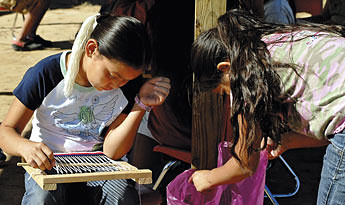|
Weaving 101
Schoolchildren learn about Navajo tradition

Adrienne Yazzie weaves intently during a weaving camp at Chee Dodge
Elementary School Wednesday. Yazzie planned to weave little blocks
into her design, but was still unsure of what color she wanted to
use in the design. [Photo by Daniel Zollinger/Independent]
By Leslie Wood
Staff Writer

Children used forks to squish the yarn together while weaving
during a camp at Chee Dodge Elementary. The children have learned
the entire process of weaving, including the sheering and dying
of the wool. [Photo by Daniel Zollinger/Independent] |
GALLUP — Eighteen school-aged children learned
to weave from handmade looms as part of an in-depth study into the
role sheep play in Navajo culture.
The second- through fifth-grade pupils followed the entire process
from "fleece to rug" as described by teacher Liz Caravaca,
who organized the course along with teacher Georgia Manning.
"We want students to understand the role of sheep in Navajo
culture, particularly through weaving," Caravaca said.
The summer program is funded through a grant provided by the public
department of education to teach local pupils about Navajo culture.
The children meet each morning at Chee Dodge Elementary to participate
in hands-on activities related to the Southwest-specific theme.
"It's very hands-on," Caravaca said. " ... I've never
heard one child say 'this is boring.'"
The grant also helped purchase two sheep, so students could watch
a professional manually sheer the livestock. Students then washed
the wool with both commercial detergent and the traditional yucca
root to compare and contrast the different methods. Continuing with
tradition, the students then carded, spun and dyed the wool- all
by hand.
Grandmothers, who are experienced in the weaving process, also volunteered
to help teach the children.
"They're great role models for the kids," Caravaca said
of the women.
And on Wednesday morning, students built their own looms out of
ply board and started to weave their wool into miniature rugs, which
they can take home.
"You get to do anything with the fur," Tara Soland, a
recent Red Rock Elementary school graduate, said.
Fourth-grader Dallas Cadman said she's woven wool at home before,
but she particularly enjoys the carding process that removes twigs
and dirt from the wool.
"It makes the wool easier to spin," Cadman said.
The students have also taken field trips to the Navajo Nation Museum
and Perry Null Trading Co. during the four-week course. Adrienne
Yazzie, the current Miss Chee Dodge Elementary, enjoyed the museum
visit because she was able to meet the current Miss Navajo Nation.
Caravaca said the summer program took an unexpected turn when the
newly purchased sheep were attacked and killed by a pack of wild
dogs. The dogs broke into the pen where the sheep were being housed
and fed by students.
Teachers planned to have the sheep butchered for a traditional Navajo
feast at the close of the program. The pupils wrote about the sheep
deaths in their class journals and many children expressed concern
that local residents abandon their dogs in areas such as the field
behind the elementary school. Caravaca said she would like to start
a public awareness campaign to encourage residents to spay and neuter
their pets to prevent such incidents from occurring in the future.
"Sometimes you have to take advantage of things like this and
use them as teachable moments," Caravaca said.
|
Thursday
July 26, 2007
Selected
Stories:
Gallup Bishop
Pelotte injured
Navajo-Gallup
Water project faces an uphill battle; Opponents cite nearly $1 billion
cost as excessive
Rain
didn't dent Fire & Ice; People seeking shelter flood local businesses
Weaving
101; Schoolchildren learn about Navajo tradition
The Gallup
Gamer; The Darkness
Deaths
|



